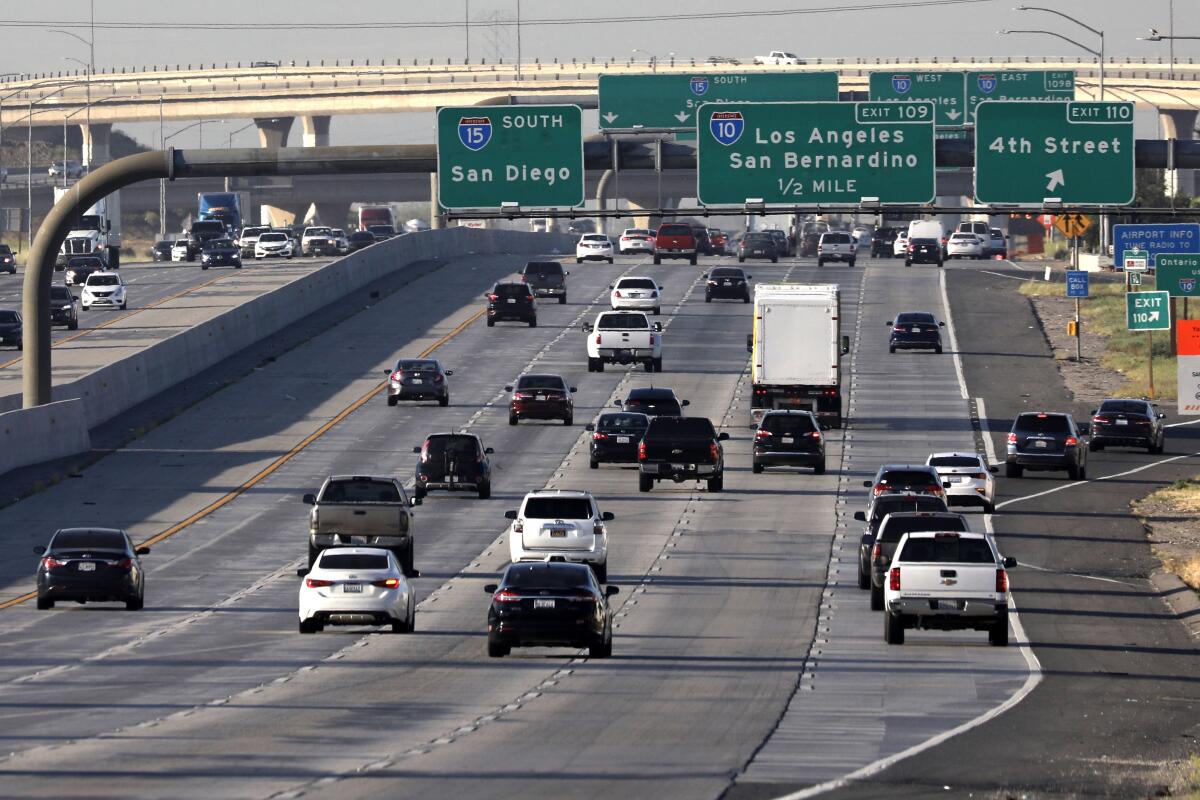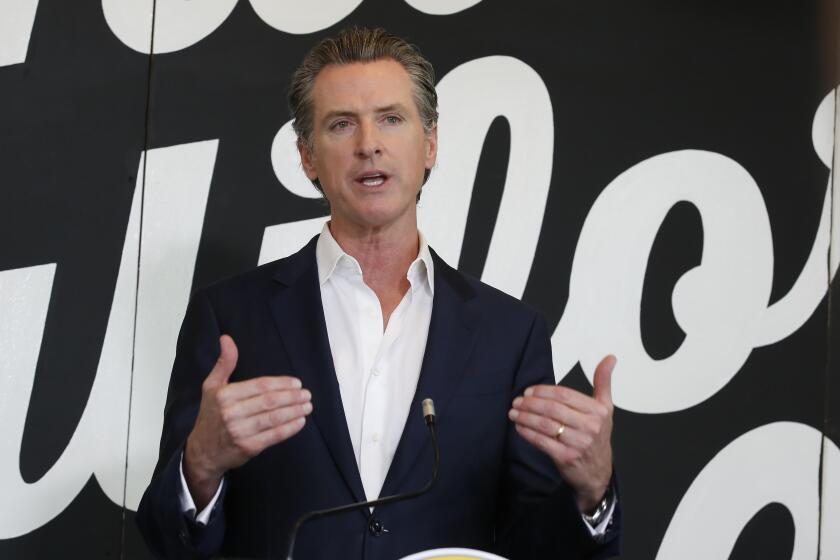L.A. traffic is starting to pick up again, and travel speeds are slowing down

- Share via
During the first month of California’s stay-at-home order, Hollywood writer Jon Hotchkiss went to great lengths to film the vast emptiness of the street grid: walking onto an onramp, lingering on overpasses, even strapping a camera on his car and driving through the sparse traffic in the Sepulveda Pass.
Last week, as cars zipped past him on Ventura Boulevard, he realized that the blissful, eerie period of no traffic was already ending.
“I’m seeing more cars everywhere,” Hotchkiss said. “It’s just strange, like: Where are all these people going?”
Like the first tender shoots of spring, or perhaps the proverbial canary in the coal mine, traffic is beginning to reappear in Los Angeles.
Congestion is still far below pre-pandemic levels. But the number of drivers who are out and about is steadily creeping upward, and travel times are retreating from the white-hot pace of late March, when the 405 Freeway saw speeds of 70 mph at rush hour.
For three straight weeks, trips taken and miles driven in Los Angeles have been on the rise, according to an analysis performed by Inrix, a traffic data company in Seattle. Miles driven are now about 54% of pre-pandemic levels, compared with 43% a month ago.
“Traffic took a dive right away,” said Bob Pishue, an Inrix transportation analyst. “We’re starting to see it slowly recover.”
Requests for driving directions through Apple Maps have surged, too.
Some residents say they’ve started shutting their windows during work calls because traffic is getting louder. Municipal buses are no longer idling at stops, ahead of schedule. Pedestrians, who strolled across major boulevards against the light a month ago, are waiting for the walk signal again.
The uptick in traffic comes as California begins its seventh week of stay-at-home orders, and the economic and emotional strain of the shutdown begins to sink in.
“People are starting to get a little stir crazy,” Hotchkiss said. “The podcasts that I listen to were doing episodes about loneliness and how incredibly debilitating it can be. And I was listening and going, ‘Oh, yeah. I’m starting to feel that, just a little.’”
After a rainy and cool March and April, temperatures are soaring into the 90s. Staying home in the heat of the afternoon is becoming unbearable for tens of thousands of residents without air conditioning.
“We drove an hour just to get out of the house,” said Michelle Miranda, 38, who loaded her two young children into the car in El Monte and went to the grocery store in Santa Monica. “The car has air conditioning but the house doesn’t.”
The Inrix analysis found that driving trips are rising on the weekends. That could be a cause for concern for California officials, who continue to warn that residents should continue to stay home whenever possible, even as they begin to tentatively reopen small sections of the economy.
“If we don’t adhere to public health orders... we are not going to get out of this mess,” Los Angeles County Supervisor Hilda Solis said Thursday, adding that people are not taking stay-at-home orders as seriously as they should. “It is going to hurt people, and it is going to hurt the economy.”
Newsom said earlier this week that bookstores, florists and others can reopen for curbside pickup Friday, unless barred by tougher local restrictions.
In Los Angeles County, some retailers, including florists, toy stores and bookshops, are now open for curbside pickup only. Golf courses and trails also reopened Friday. People still must adhere to physical distancing requirements and wear face coverings, health officials said.
Luis Duran, 29, an urban planner who lives in Hawthorne, opened Instagram this week and saw multiple friends complaining about bumper-to-bumper traffic on major freeways. He opened Google Maps and took a screenshot of the dark red lines, signifying heavy congestion, on the northbound 405 and the 10 Freeway between downtown and Santa Monica.
“Why are there so many red lines when we’re all supposed to be home?” Duran said. “The streets should still be empty.”
He posted the screenshot on Instagram with the caption: “I didn’t know all the stay-at-home orders were lifted already?” For good measure, he added a smirking emoji.
So, with freeways fuller, where are people going?
Trips to grocery stores and pharmacies in Los Angeles County have risen slightly since April, according to data analyzed by Google. Trips to parks have increased, too, with the number of visits about 40% lower than usual in May, compared with 80% lower than usual in April.
Some people, chafing under the requirements of staying home all day, or struggling to work at home with roommates or a spouse, are heading back to the office.
From his office in the Equitable Life Building in Koreatown, attorney Matthew Strugar, 41, has a clear view of Wilshire Boulevard. Over the last two weeks, he said, traffic has slowly gotten worse, to the point that some drivers don’t make it down a block before the light turns red again.
The lobby of his building was a ghost town for weeks. Now, he said, he sometimes has to wait for the next elevator so he can ride up alone to his office, where he works by himself.
He’s leaving the house to give his wife space to work from their home in Echo Park. The extra people on the road, he said, must be “feeling some fatigue, and because it helps with that interpersonal element at home.”
As Strugar bikes home, he sometimes pulls over, opens Google Maps and takes a screenshot of where traffic seems to be getting worse. On Wednesday, the 405 through the Sepulveda Pass was a familiar shade of dark red.
More to Read
Sign up for Essential California
The most important California stories and recommendations in your inbox every morning.
You may occasionally receive promotional content from the Los Angeles Times.















